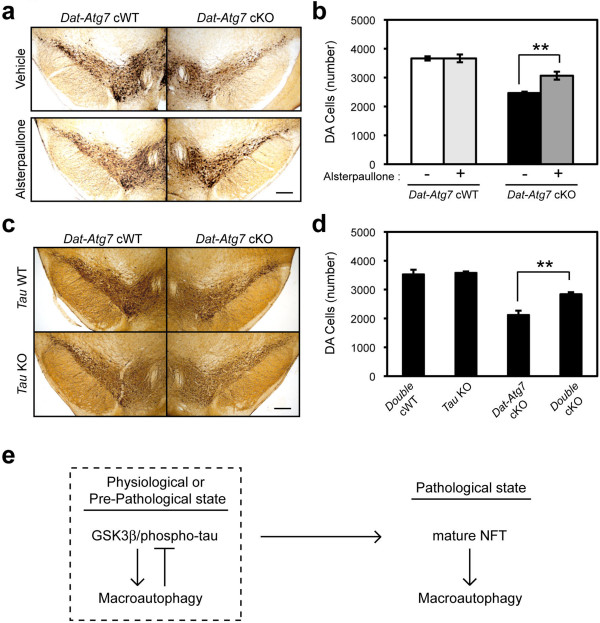Figure 5.

Neuroprotection of Atg7-deficient CNS neurons in vivo. (a-b) Pharmacological rescue of Atg7-deficient midbrain DA neuron loss by systemic injection of the selective GSK3β/CDK5 inhibitor Alsterpaullone. Five-week-old mice were dosed daily with 5 mg/kg Alsterpaullone by intraperitoneal injection for a 3-week period prior to analysis. TH-positive DA neuron loss was suppressed in Alsterpaullone-treated Dat-Atg7 cKO mice, whereas Alsterpaullone-treated control Dat-Atg7 cWT mice were unaffected. b, Quantification of TH-positive DA neuron number. **, P < 0.01. n = 5 - 6 / group. (c-d) Genetic rescue of DA neuron death in Atg7-deficient mice by secondary tau deletion. Immunostaining for TH-positive DA neurons at 3-month of age revealed significant protection of midbrain DA neurons from neurodegeneration in Atg7 single KO mice (Dat-Atg7 cKO) relative to controls (Dat-Atg7/tau double cWT). d, Quantification of TH-positive DA neuron number. **, P < 0.01. n = 4 - 6 / group. (e) Proposed model of phospho-tau and GSK3β regulation by macroautophagy. In physiological or pre-pathological states, basal macroautophagy regulates endogenous levels of phospho-tau and GSK3β (dashed square). In pathological states or with aging, macroautophagy is impeded, and phospho-tau and GSK3β are accumulated. These in turn lead to feedback induction of the macroautophagy pathway, although such feedback is ineffective in late-stage disease or in knockout mice.
